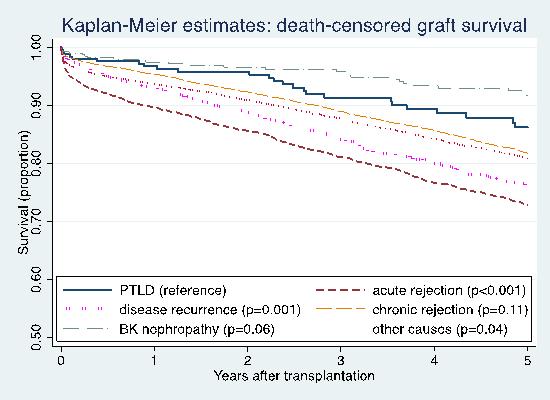Outcomes of Kidney Retransplantation after Post-Transplant Lymphoproliferative Disorders: An Analysis of the UNOS/OPTN Database (1998 to 2019)
1Nephrology, University of Mississippi Medical Center, Jackson, MS, 2Nephrology and Hypertension, Mayo Clinic, Rochester, MN, 3Transplant Surgery, Mayo Clinic, Phoenix, AZ, 4Renal Transplant Program, University of Missouri-Kansas City School of Medicine/Saint Luke's Health System, Kansas City, MO
Meeting: 2020 American Transplant Congress
Abstract number: 499
Keywords: Kidney transplantation, Outcome, Post-transplant lymphoproliferative disorder (PTLD), Retransplantation
Session Information
Session Time: 3:15pm-4:45pm
 Presentation Time: 3:27pm-3:39pm
Presentation Time: 3:27pm-3:39pm
Location: Virtual
*Purpose: Post-transplant lymphoproliferative disease (PTLD) is a serious, potentially fatal complication after kidney transplantation. Existing literature on outcomes of kidney retransplantation in patients with prior PTLD is scarce.
*Methods: The UNOS database was used to identify adult patients with end-stage renal disease who received their second kidney-only transplant from year 1998 to 2019. The patients were categorized into 2 groups based on history of PTLD. The outcomes of this study were death-censored graft survival and patient survival. The difference in outcomes between PTLD and non-PTLD groups was analyzed using Cox proportional hazard analysis.
*Results: Of 32,867 patients who had second kidney transplant, 258 patients had history of PTLD after their first kidney transplant. The median time of PTLD diagnosis after the first kidney transplant was 846 (IQR 263-2671) days, whereas the median time from PTLD diagnosis to the kidney re-transplant was 2909 (IQR 1904-4093) days. Over the median follow-up time of 1465 (IQR 705-2745) days after their kidney re-transplant, there was no significant difference in death-censored graft survival (86% vs. 81% at 5 years; p=0.06) and patient survival (89% vs. 87% at 5 years; p=0.49) between PTLD and non-PTLD groups. In adjusted analysis, history of PTLD in the first kidney transplant was not significantly associated with death-censored graft survival (HR 0.71; 95% CI 0.51-0.97) and patient survival (HR 1.20; 95% CI 0.87-1.65). Analysis of death-censored graft survival among different specific causes of graft failure showed that patients in PTLD groups had better graft survival than patients with the first graft failure due to acute rejection (p=0.001), disease recurrence (p=0.002), but comparable to patients with the first graft failure due to chronic rejection ((p=0.06), BK nephropathy (p=0.57), and other causes (p=0.08). Of note, 8 (3.1%) out of 258 patients developed PTLD again after their kidney re-transplant.
*Conclusions: In the United States, outcomes of retransplantation in patients with history of PTLD were comparable to those without history of PTLD.
To cite this abstract in AMA style:
Cheungpasitporn W, Thongprayoon C, Jadlowiec CC, Chon WJ, Cummings LS, Katari SR, Leeaphorn N. Outcomes of Kidney Retransplantation after Post-Transplant Lymphoproliferative Disorders: An Analysis of the UNOS/OPTN Database (1998 to 2019) [abstract]. Am J Transplant. 2020; 20 (suppl 3). https://atcmeetingabstracts.com/abstract/outcomes-of-kidney-retransplantation-after-post-transplant-lymphoproliferative-disorders-an-analysis-of-the-unos-optn-database-1998-to-2019/. Accessed December 16, 2025.« Back to 2020 American Transplant Congress

